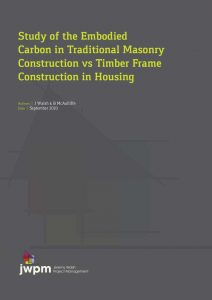Embodied Energy
The “Effort Sharing Regulation” (ESR) [1], sets out binding annual greenhouse gas emission targets for EU Member States for each year for the period 2021-2030. These targets cover sectors of the economy that fall outside the scope of the EU Emissions Trading System (EU ETS) [2]. These sectors, including transport, buildings, agriculture and waste management, account for almost 60% of total EU emissions and 74% for Ireland. The ESR, and the Irish Government in the National Energy and Climate
Plan 2021-2030 [3], enshrines a greenhouse gas emissions reduction target for Ireland of 30% by 2030 relative to 2005 levels and whilst there are no individual targets for each sector it is clear that the building industry must play its part.
The built environment is a major contributor to greenhouse gas emissions with the energy associated with building use accounting for 24% of energy-related CO2 emissions in Ireland in 2018; [4]. The emissions associated with the manufacturing, transportation, construction and end of life phases, commonly referred to as embodied carbon, contribute around 11% of all global carbon emissions.
As the levels of insulation and associated construction thickness have increased to comply with the necessary improvements in the building regulations (Part L, [5]) the embodied energy and associated embodied carbon, in absolute terms and as a proportion of the overall lifecycle energy of a building is rising. Furthermore, as the operational energy performance of new buildings is improving to the point where there is diminishing returns by improving element u-values and airtightness it is logical that focus would progress to how the embodied energy of a building, estimated to reach 50% of building lifecycle carbon emissions by 2050, can be reduced.
A better understanding of the embodied carbon associated with building materials and construction types will allow building designers and developers to build lower carbon homes. This study aims to compare the embodied energy of the two most typically used construction types, namely tradition masonry construction and timber frame, by using a life cycle assessment tool. By selecting two near Zero Energy Building (NZEB) compliant houses in the same housing estate and not including building finishes in the analysis we aim to compare the construction types. The results will also be used to look at ways of improving the selection of construction methods and the specification of building materials to help reduce the industry’s carbon footprint. The purpose of this study was to
inform future in-house decisions on the specifications of building materials and construction types.



